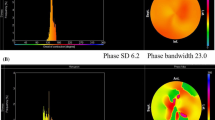Abstract.
Accurate assessment of myocardial viability permits selection of patients who would benefit from myocardial revascularization. Currently, rest-redistribution thallium-201 scintigraphy and low-dose dobutamine echocardiography are among the most used techniques for the identification of viable myocardium. Thirty-one consecutive patients (all men, mean age 60±8 years) with chronic coronary artery disease and reduced left ventricular ejection fraction (31%±7%) were studied. Rest 201Tl single-photon emission tomography (SPET), low-dose dobutamine echocardiography and radionuclide angiography were performed before revascularization. Radionuclide angiography and echocardiography were repeated after revascularization. An a/dyskinetic segment was considered viable on 201Tl SPET when tracer uptake was >65%, while improvement on low-dose dobutamine echocardiography was considered a marker of viability. Increase in global ejection fraction was considered significant at ≥5%. In identifying viable segments, rest 201Tl SPET showed higher sensitivity than low-dose dobutamine echocardiography (72% vs 53%, P<0.05), while specificity was not significantly different (86% vs 88%). In 17 patients, global ejection fraction increased ≥5% (group 1) while in 14 it did not (group 2). A higher number of a/dyskinetic segments were viable on 201Tl SPET in group 1 than in group 2 (2.6±1.9 vs 0.6±1.2, P<0.005), while no significant differences were observed on low-dose dobutamine echocardiography (1.7±1.6 vs 1.1±1.6). A significant correlation was found between the number of a/dyskinetic segments viable on 201Tl SPET and post-revascularization changes in ejection fraction (r=0.52, P<0.05), but such a correlation was not observed for low-dose dobutamine echocardiography. Using as the cut-off the presence of at least one viable a/dyskinetic segment, rest 201Tl SPET had a higher sensitivity (82% vs 53%, P=0.07) and showed a trend towards higher accuracy and specificity (77% vs 58%, and 71% vs 64%, respectively) as compared with low-dose dobutamine echocardiography. In conclusion, these findings suggest that when severely reduced global function is present, rest 201Tl SPET evaluation of viability is more accurate than low-dose dobutamine echocardiography for the identification of patients who will benefit most from revascularization.
Similar content being viewed by others
Author information
Authors and Affiliations
Additional information
Received 20 May and in revised form 2 August 2000
Electronic Publication
Rights and permissions
About this article
Cite this article
Pace, L., Perrone-Filardi, P., Storto, G. et al. Prediction of improvement in global left ventricular function in patients with chronic coronary artery disease and impaired left ventricular function: rest thallium-201 SPET versus low-dose dobutamine echocardiography. Eur J Nucl Med 27, 1740–1746 (2000). https://doi.org/10.1007/s002590000374
Published:
Issue Date:
DOI: https://doi.org/10.1007/s002590000374




